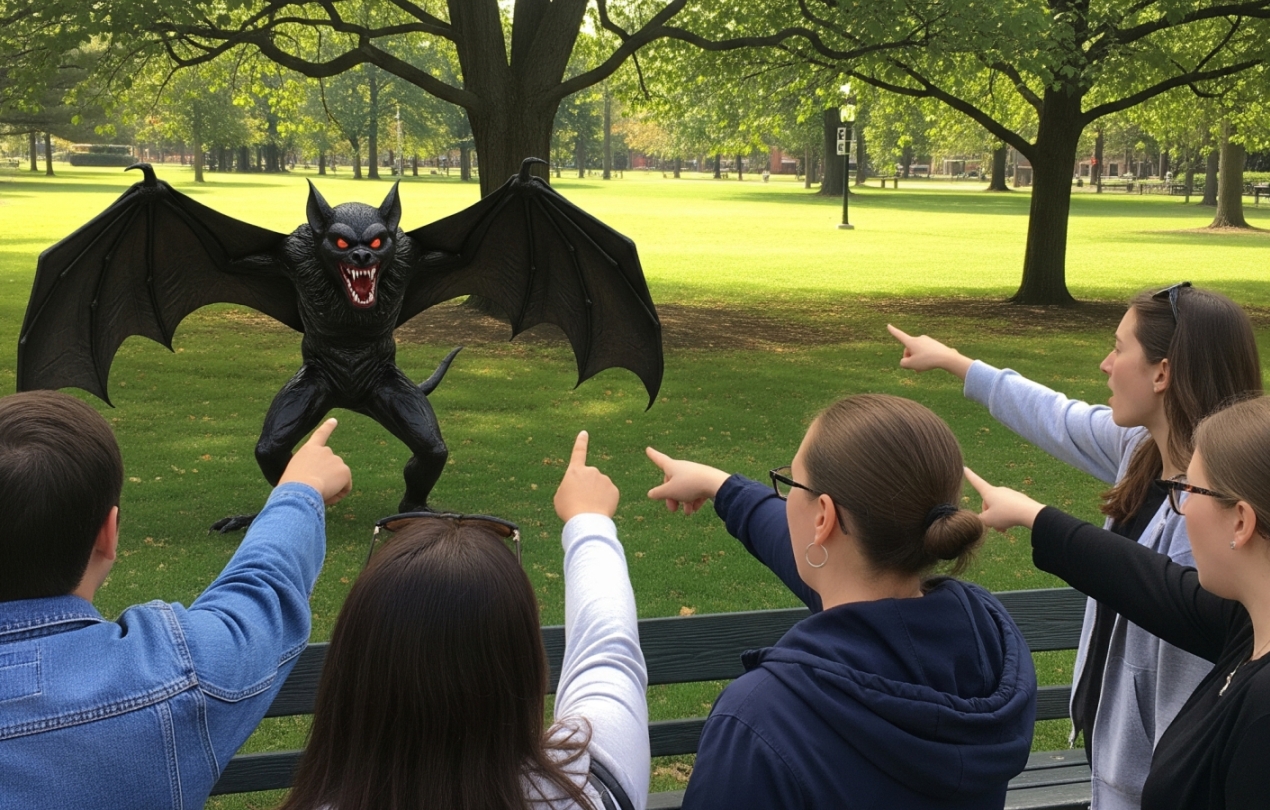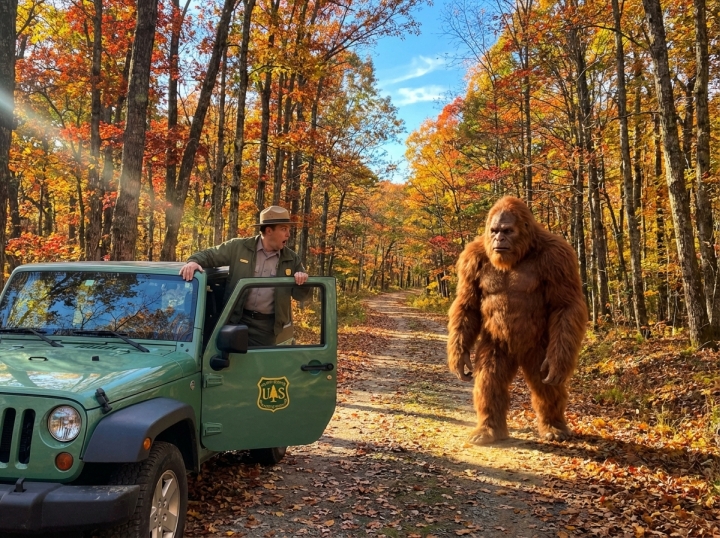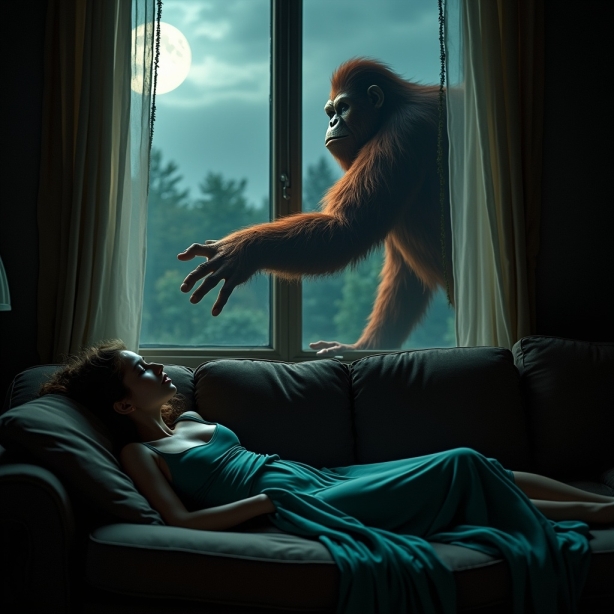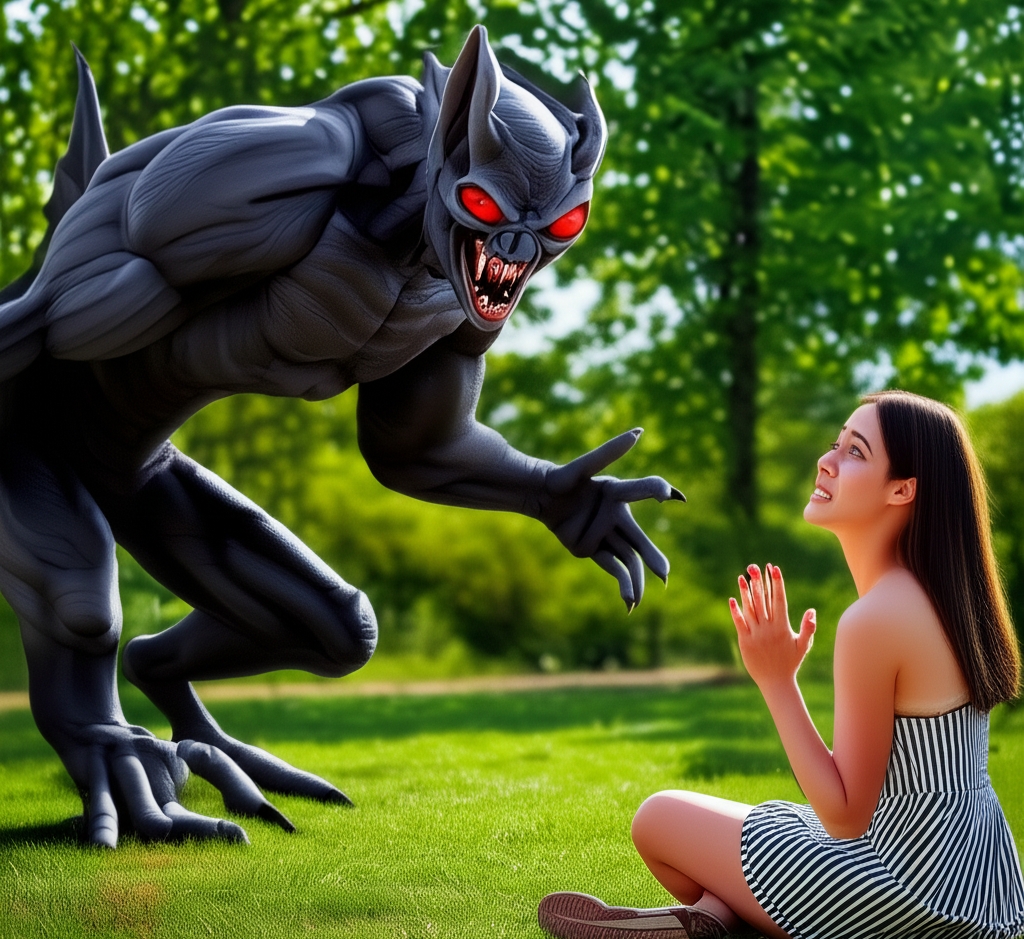
Deep within the dense, mysterious forests of southern New Jersey lies a legend that has haunted the region for well over two centuries—the tale of the Jersey Devil. A creature of folklore and fear, the Jersey Devil has become a fixture of American mythology, captivating the imaginations of locals, skeptics, and paranormal enthusiasts alike.
The most common origin story of the Jersey Devil dates back to the early 18th century. According to folklore, a woman named Mother Leeds, living in the Pine Barrens, the mistress of a British soldier, was pregnant with her 13th child. Frustrated and overwhelmed by her growing family and the hardships of colonial life, she allegedly cursed the unborn child in exasperation, crying, “Let this one be a devil!”
On a stormy night in 1735, the child was born—normal at first—but soon transformed into a monstrous creature with leathery wings, a goat’s head, hooves, and a forked tail. Screeching wildly, it flew up the chimney and disappeared into the night, beginning centuries of sightings and speculation.
The Jersey Devil is typically described as a bipedal creature, around 3 to 4 feet tall, with bat-like wings, clawed hands, and the head of a horse or goat. Its eerie cry is said to resemble a high-pitched scream or a human wail, echoing through the trees and unsettling even the most hardened outdoors men.
Sightings of the Jersey Devil have been reported as early as the 18th century, with notable flurries of encounters in the 19th and early 20th centuries. In 1909, a wave of reports from across New Jersey and even neighboring states caused widespread panic. Newspapers at the time published stories of mysterious tracks, livestock killings, and even attacks, prompting schools to close and vigilante groups to form.
Sightings of the Jersey Devil—a legendary creature said to inhabit the Pine Barrens of southern New Jersey—span over 250 years, with witness accounts ranging from the bizarre to the terrifying. Below are very detailed descriptions of notable and representative sightings from various time periods, as reported by witnesses. These accounts often share common features, but each has unique aspects that contribute to the enduring mythos.
Navy Commander Stephen Decatur’s Account (Early 1800s) Witness: Commodore Stephen Decatur (U.S. Navy heWhile testing cannonballs at Hanover Mills Works, Decatur saw a strange creature flying overhead. While testing cannonballs at Hanover Mills Works, Decatur saw a strange creature flying overhead. He reportedly fired a cannonball directly into it, but the creature continued flying unharmed. Described as large,winged and not resembling any known bird.His account was later cited by believers as credible due to his military service.
Joseph Bonaparte’s Encounter with the Jersey Devil (circa 1820s). Joseph Bonaparte, elder brother of Napoleon Bonaparte, and former King of Spain: After Napoleon’s defeat, Joseph Bonaparte fled Europe and lived in exile in the United States. He bought a large estate in Bordentown, New Jersey, near the Pine Barrens — the region most famously associated with the Jersey Devil. One winter day in the early 1820s, while hunting alone in the woods near his estate, Bonaparte claimed he came across peculiar tracks in the snow — unlike any animal he had seen. The prints were cloven-hoofed but did not follow a straight path, sometimes disappearing and reappearing inexplicably, as though the creature had taken flight.While inspecting the tracks, Bonaparte reported that he was startled by a strange, winged creature that emerged from the trees. He described it as having: a horse-like head, bat-like wings,a long serpent-like tail, and clawed feet. The creature hissed or let out a chilling screech and flew away into the trees, leaving Bonaparte shaken. According to the legend, he later told locals of the encounter, who then explained to him the lore of the Leeds Devil-now wildey known as the Jersey Devil.
There is no official written account or diary entry from Joseph Bonaparte himself describing this encounter, and most historians believe the tale likely emerged from local folklore and was attributed to him later to lend it prestige and intrigue.
However, it’s a popular and persistent tale that combines early American folklore with European nobility — giving it a special place in the lore of the Pine Barrens.
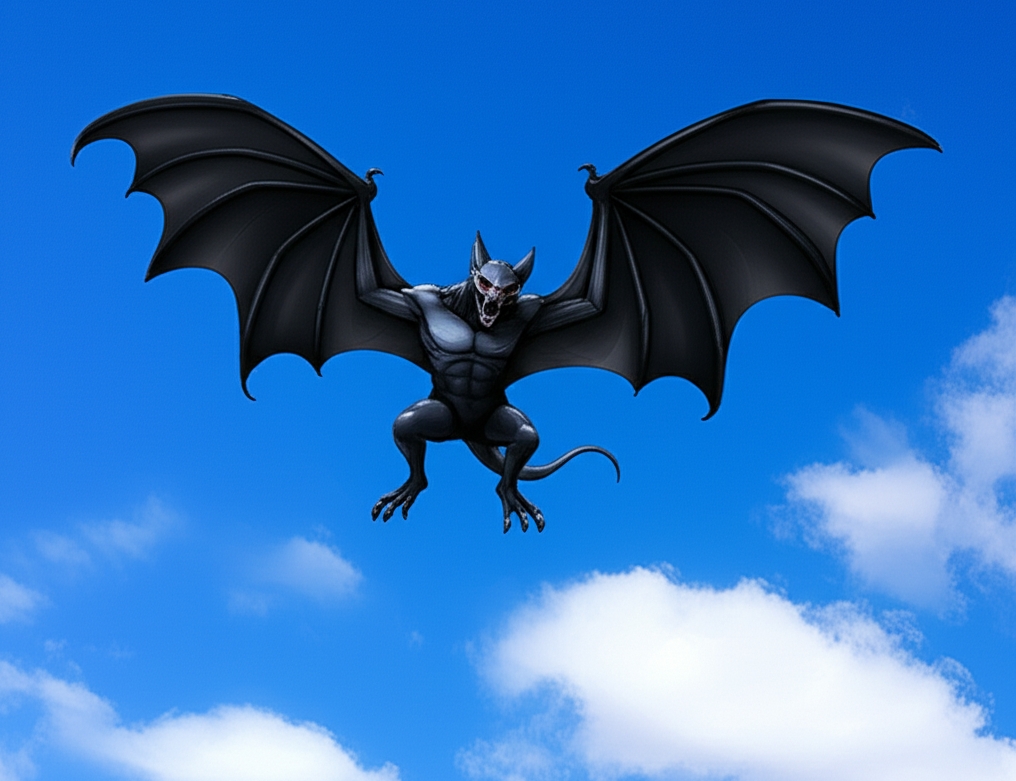
The Most Documented Series of Sightings.
During January 16–23, 1909, hundreds of sightings were reported across New Jersey, Pennsylvania, and Delaware. Here are several detailed accounts from that week:
Bristol, Pennsylvania – January 16, 1909 Witness: Patrolman James Sackville saw a large creature flying over the town at night; it emitted unearthly,high=pitched screams unlike any other bird or animal. He described it as having horse-like face, long neck, thin body, bat wings, and cloven feet. Its eyes glowed red in the dark, and its wings bet silently through the air.
Haddon Heights, NJ – January 19, 1909 Witnesses: Mrs. Sorbinski and her children. They saw a strange creature in their backyard. It was feeding on a garbage can. Had a kangaroo stance with two short arms, featherless wings, and a head resembling a horse or a dog. When started, it leapt over a fence, and flew into the woods. Left hof like racts in the snow which later led nowhere-abruptly ending in the middle of fields or rooftops.
Trenton, NJ – January 21, 1909 Witness: City Councilman E.P. Weeden. Woke to flapping sounds outside his window. Woke to flapping sounds outside his window.Observed a creature on the roof of his shed. Estimated height: around 3½ feet. Had a head like a collie dog, face like a horse, wings about 2 feet long, and rear legs with hooves. Said it walked upright, flapped its wings, and flew with a hiss. Found cloven foot prints in the snow on the roof the next morning.
Farmer Encounter – 1927, Greenwich, NJ Witness: a local cabdriver named Joseph Bonaparte; relative of Napoleon. Claimed he saw the creature while hunting in the woods. Described it as a gray winged beast with a horse-like face, long back legs, and short front legs. Said it made a blood-curdling scream,and moved trough the air with effortless gliding, despite its size.
1960s Sightings – Mays Landing, NJ Witnesses: several residents. Multiple residents heard strange screeching noises at night.A few claimed to see a creature with glowing red eyes, reddish hair, wingspan over five feet and jumping ability akin to a deer. Police responded and even baited traps, though nothing was caught. Sightings coincided with pets disappearing and livestock turning up mutilated.
1980 – Wharton State Forest Camper Encounter. Witness: Unnamed camper. Claimed he saw a large winged creature after hearing a loud crashing through the under bush. Described as over six feet tall with a serpentine neck, leathery wings, and a tail that swished like a whip. Said the creature stopped, looked at him with yellow eyes, and let out a deep guttural growl before launching into the air with a powerful leap.
1993 – Mullica River Canoeist Encounter. Witness: Solo Canoeist. At twilight, heard flapping wings and saw a dark figure with elongated legs perched on a tree. Described the creature as a having a goat-like face; thin,membrane wings, hoofed feet, matted fur, and a pugnent odor. Said it vanished almost silently, except for a faint hissing sound. Claimed to have found strange clawed prints in the muddy river bank.
2000s to Present – Modern Reports. While rarer, there are still occasional reports. Witnesses describe loud, unnatural screeches or bizarre animal tracks a flying creature with a bat-like silhouette, often seen near the edges of Pine Barrens at dusk. Sometimes mistaken for sandhill cranes or large owls, but usually accompanied by odd smells, missing animals or mechanical sounding noises.
Skeptics and historians offer several theories to explain the legend. Some suggest that the story originated as a political or religious allegory, possibly targeting Daniel Leeds, an early settler whose family was associated with unpopular beliefs and the publication of almanacs that clashed with Quaker orthodoxy. There was historical local disdain for the Leeds family. Others attribute sightings to misidentified animals, such as owls, deer, or even large birds like the sandhill crane.
The dense wilderness of the Pine Barrens—a sprawling, sparsely populated area with a long history of isolation—provides fertile ground for myths. The area’s geography and lack of modern infrastructure in earlier centuries likely contributed to the persistence and embellishment of the tale.
In 1909, alleged Jersey Devil footprints resembled a horse’s hoof and the writer Gordon Stein in the book “Encyclopedia of Hoaxes”,wrote that a man later admitted he faked some of those footprints.
The writer Geoff Tibballs in the book “The World’s Greatest Hoaxes” (2006) writes that a certain Norman Jeffries, a publicist for Philadelphia’s Arch Museum and he was a much known hoaxer,when told by the museum proprietor T.F.Hopkins to “drum-up”; acquire more paid attendants or the museum would close down; Jeffries supplied local newspapers various fictional sightings and false testimonies to newspapers on the Jersey Devil and in 1909 he and his friend Jacob Hope, an animal trainer, bought a kangaroo from a circus, glued artificial claws and bat wings on it and put the disguised animal on public display at the museum as “the captured Jersey Devil”. Norman Jeffries admitted to the hoax twenty years later in 1929.
Regardless of its origin, the Jersey Devil has become an indelible part of New Jersey culture. It serves as the namesake for the NHL’s New Jersey Devils hockey team and features prominently in local literature, art, and tourism. The creature appears in TV shows, documentaries, and horror films, reflecting its place in the broader canon of American cryptids alongside Bigfoot and the Mothman. The image of the Jersey Devil appears on t-shirts, buttons, postcards, and there are Jersey Devil cocktails.
Each year, thrill-seekers and folklore fans venture into the Pine Barrens hoping to catch a glimpse of the legendary beast—or at least to feel the eerie chill of its myth. Towns in the region hold festivals and events inspired by the story, and local shops sell Devil-themed merchandise, blending commerce with folklore.
Whether a figment of imagination, a misunderstood animal, or a supernatural entity, or just made up stories, the Jersey Devil continues to fascinate. Its legend is a testament to the power of folklore to shape regional identity and endure through centuries of retelling. In the shadowy woods of the Pine Barrens, the story lives on—waiting for the next scream in the night, the next unexplained track in the snow, soil, or the mud.
